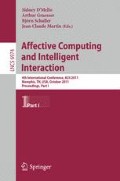Abstract
We investigate how lighting can be used to influence how the personality of virtual characters is perceived. We propose a character-centric lighting system composed of three dynamic lights that can be configured using an interactive editor. To study the effect of character-centric lighting on observers, we created four lighting configurations derived from the photography and film literature. A user study with 32 subjects shows that the lighting setups do influence the perception of the characters’ personality. We found lighting effects with regard to the perception of dominance. Moreover, we found that the personality perception of female characters seems to change more easily than for male characters.
Access this chapter
Tax calculation will be finalised at checkout
Purchases are for personal use only
Preview
Unable to display preview. Download preview PDF.
References
Amaya, K., Bruderlin, A., Calvert, T.: Emotion from motion. In: Davis, W.A., Bartels, R. (eds.) Graphics Interface 1996, pp. 222–229. Canadian Human-Computer Communications Society (1996)
Chi, D.M., Costa, M., Zhao, L., Badler, N.I.: Emote. In: Akeley, K. (ed.) Siggraph 2000, Computer Graphics Proceedings, pp. 173–182. ACM Press/ACM SIGGRAPH/Addison Wesley Longman (2000)
Courgeon, M., Buisine, S., Martin, J.-C.: Impact of expressive wrinkles on perception of a virtual character’s facial expressions of emotions. In: Ruttkay, Z., Kipp, M., Nijholt, A., Vilhjálmsson, H.H. (eds.) IVA 2009. LNCS, vol. 5773, pp. 201–214. Springer, Heidelberg (2009)
Courty, N., Lamarche, F., Donikian, S., Marchand, É.: A cinematography system for virtual storytelling. In: Balet, O., Subsol, G., Torguet, P. (eds.) ICVS 2003. LNCS, vol. 2897, pp. 30–34. Springer, Heidelberg (2003)
de Melo, C., Gratch, J.: Evolving expression of emotions in virtual humans using lights and pixels. In: Prendinger, H., Lester, J.C., Ishizuka, M. (eds.) IVA 2008. LNCS (LNAI), vol. 5208, pp. 484–485. Springer, Heidelberg (2008)
de Melo, C., Paiva, A.: Environment expression: Telling stories through cameras, lights and music. In: Subsol, G. (ed.) ICVS-VirtStory 2005. LNCS, vol. 3805, pp. 129–132. Springer, Heidelberg (2005)
Seif El-Nasr, M.: Intelligent lighting for game environments. Journal of Game Development 1(2), 17 (2005)
Hartmann, B., Mancini, M., Pelachaud, C.: Implementing expressive gesture synthesis for embodied conversational agents. In: Gibet, S., Courty, N., Kamp, J.-F. (eds.) GW 2005. LNCS (LNAI), vol. 3881, pp. 188–199. Springer, Heidelberg (2006)
Heloir, A., Kipp, M.: Realtime animation of interactive agents: Specification and realization. Applied Artificial Intelligence 24(6), 510–529 (2010)
Millerson, G.: Lighting for Television and Film. Focal Press, Oxford (1999)
Neff, M., Wang, Y., Abbott, R., Walker, M.: Evaluating the effect of gesture and language on personality perception in conversational agents. In: Allbeck, J., et al. (eds.) IVA 2010. LNCS, vol. 6356, pp. 222–235. Springer, Heidelberg (2010)
Neviarouskaya, A., Prendinger, H., Ishizuka, M.: Emoheart: Conveying emotions in second life based on affect sensing from text. In: Advances in Human-Computer Interaction. Springer, Heidelberg (2010)
Oosterhof, N., Todorov, A.: The functional basis of face evaluation. Proc. of the National Academy of Sciences of the United States of America (2008)
Ortony, A., Clore, G., Collins, A.: The Cognitive Structure of Emotions. Cambridge University Press, Cambridge (1988)
Ratcliff, J.J., Lassiter, G.D., Schmidt, H.C., Snyder, C.L.: Camera perspective bias in videotaped confessions: experimental evidence of its perceptual basis. Journal of Experimental Psychology: Applied 12, 197–206 (2006)
Schröder, M.: Expressive speech synthesis: Past, present, and possible futures, affective information processing. In: Tao, J., Tan, T. (eds.) Affective Information Processing, pp. 111–126. Springer, Heidelberg (2009)
Wiggins, J.S.: A psychological taxonomy of trait-descriptive terms: The interpersonal domain. Journal of Personality and Social Psychology 37, 395–412 (1979)
Author information
Authors and Affiliations
Editor information
Editors and Affiliations
Rights and permissions
Copyright information
© 2011 Springer-Verlag Berlin Heidelberg
About this paper
Cite this paper
Heloir, A., Kipp, K.H., Kipp, M. (2011). Using Individual Light Rigs to Control the Perception of a Virtual Character’s Personality. In: D’Mello, S., Graesser, A., Schuller, B., Martin, JC. (eds) Affective Computing and Intelligent Interaction. ACII 2011. Lecture Notes in Computer Science, vol 6974. Springer, Berlin, Heidelberg. https://doi.org/10.1007/978-3-642-24600-5_15
Download citation
DOI: https://doi.org/10.1007/978-3-642-24600-5_15
Publisher Name: Springer, Berlin, Heidelberg
Print ISBN: 978-3-642-24599-2
Online ISBN: 978-3-642-24600-5
eBook Packages: Computer ScienceComputer Science (R0)

